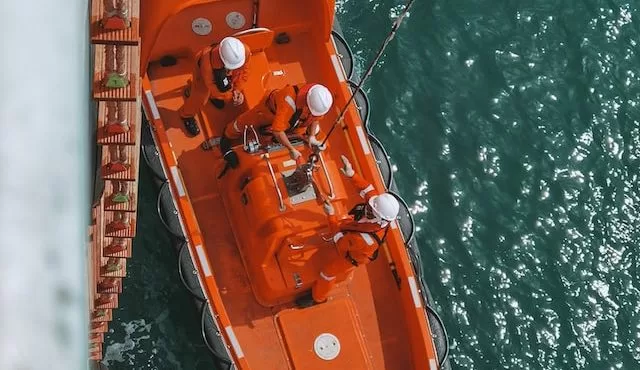Lifeboats are designed for use in emergencies when a vessel is sinking or has been damaged and its passengers need to evacuate. Rescue boats, on the other hand, are used to rescue people who have fallen overboard or are in distress in the water.
Lifeboats Vs. Rescue boats – Key differences
There are several key differences between lifeboats and rescue boats. Lifeboats are typically larger and more robust, designed to carry more people and better withstand harsh weather conditions. Rescue boats, on the other hand, are smaller and more agile, designed for speed and manoeuvrability.
Another key difference is that lifeboats are typically equipped with supplies for extended stays at sea, while rescue boats are not. Lifeboats also have a self-contained water supply and filtration system, while rescue boats do not.
Finally, lifeboats are designed to be launched from a larger vessel in an emergency, while rescue boats are typically carried on board a vessel as a form of onboard emergency response.
Can a lifeboat be a rescue boat?
In general, lifeboats are designed to be used as a last resort in the event of a shipwreck or other emergency. On the other hand, rescue boats are typically used for search and rescue operations. While a lifeboat can technically be used as a rescue boat, it is not ideal for this purpose since it is not designed with search and rescue operations in mind.
Why are lifeboats and rescue boats orange?
There are a few reasons why lifeboats and rescue boats are orange. The most obvious reason is that orange is a very visible colour, both in daylight and at night. This makes it easier for people in the water to spot a lifeboat or rescue boat, and also makes it easier for rescuers to spot someone in lifeboats who may need help.
Also, the colour orange can help to calm people who are in a panic or who are feeling overwhelmed. Seeing an orange lifeboat or rescue boat can help to remind people that there is help available and that they are not alone.
Orange is also a colour that is associated with safety. When people see an orange lifeboat or rescue boat, they know that it is a safe place to be. This can help put people’s minds at ease when in a potentially dangerous situation.
Are lifeboats unsinkable?
Most lifeboats are designed to be unsinkable, or at least to float even when filled with water. This is accomplished by making them out of materials that are buoyant, such as foam or air-filled chambers. However, even the most well-designed lifeboat can sink if it is overloaded or takes on water too quickly.
Why are lifeboats usually double-ended?
Lifeboats are usually double-ended so that they can be launched from either side of a ship. This allows for greater flexibility in rescue operations. Double-ended lifeboats also have the advantage of being able to be rowed in either direction, which can be helpful when navigating through rough waters.
What are rescue boats made of?
They are typically made from fibreglass or aluminium. They are designed to be lightweight and manoeuvrable so that they can quickly reach people in distress. Many rescue boats are also equipped with special features such as inflatable sides or awnings, which can provide additional protection for those on board.
How fast do rescue boats go?
The average speed of a rescue boat is between 25 and 30 knots, which is equivalent to approximately 29-35 miles per hour. Some rescue boats are capable of reaching speeds up to 50 knots, which is approximately 58 miles per hour.
History of lifeboats
The earliest lifeboats were designed in the 18th century by the Scottish engineer William Thomson. The first recorded use of a lifeboat was in 1785 when a boat was used to rescue passengers from a burning ship.
In the 19th century, lifeboats became increasingly common, as shipwrecks became more frequent. The first purpose-built lifeboat station was established in 1802 in Dover, England. By the middle of the century, there were over 1000 lifeboat stations around the coast of Britain and Ireland.
History of rescue boats
Rescue boats have a long and varied history, with many different designs and purposes. Early rescue boats were often little more than rafts or small boats that could be launched from a ship in an emergency. These early rescue boats were usually not designed for long-distance travel or heavy weather and were often not very stable or seaworthy.
As maritime travel became more common and ships got larger and more complex, the need for dedicated rescue boats also increased. Modern rescue boats are designed specifically for rescuing people from the water and are usually much larger and more robust than early lifeboats. They are also equipped with modern safety features and communications equipment, making them better equipped to deal with emergencies at sea.
Modern-day lifeboats and rescue boats
Modern-day lifeboats include inflatable boats, rigid-hulled inflatable boats, and rigid-hulled boats. Inflatable boats are the most common type of lifeboat in use today. They are usually made from a PVC or Hypalon material and have a self-righting design. This means that if they capsize, they will right themselves and not fill with water. Rigid-hulled inflatable boats (RHIBs) are similar to inflatable boats but have a rigid hull made from aluminium or fibreglass. RHIBs are faster and more manoeuvrable than inflatable boats but are also more expensive. Rigid hulled boats (RHBs) are the largest and most stable type of lifeboat. They are typically made from steel or aluminium and can carry a large number of people. RHBs are the slowest and least manoeuvrable of the three types of lifeboats, but they are the most durable and can be used in rough seas.
Rescue boats include jet skis, hovercrafts, and helicopters. Jet skis are fast and manoeuvrable, making them ideal for rescuing people from beaches or other areas where there is shallow water. Hovercrafts can travel over land or water and can be used in a variety of rescue scenarios.








